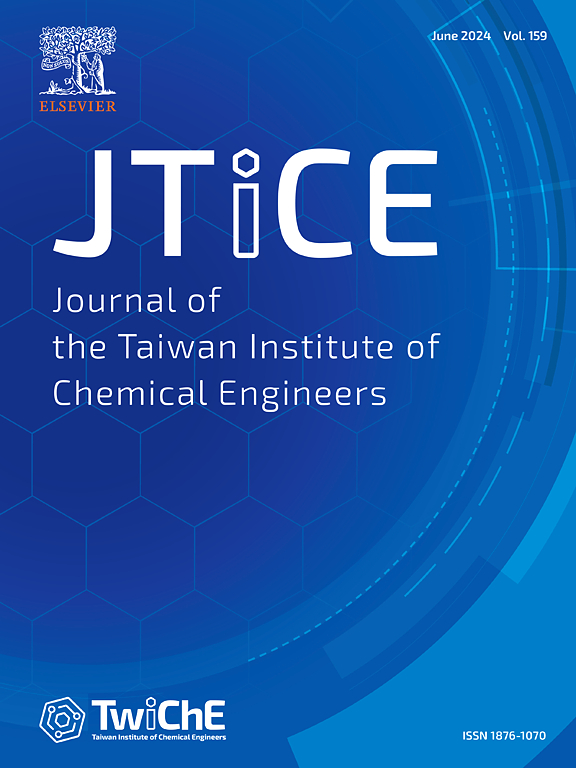快速制备固态聚合物光子晶体薄膜的层状叠加结构的重合增强和对准
IF 5.5
3区 工程技术
Q1 ENGINEERING, CHEMICAL
Journal of the Taiwan Institute of Chemical Engineers
Pub Date : 2025-03-31
DOI:10.1016/j.jtice.2025.106107
引用次数: 0
摘要
背景通过控制组成嵌段的化学性质、聚合度和体积分数,嵌段共聚物的微相分离可以形成不同维度的有序微结构。具有有序微结构的嵌段共聚物光子晶体(PC)凝胶可进行定制,以操纵光子带隙和光传播特性,从而感应各种刺激。为了扩大应用,有必要在固态下制造嵌段共聚物 PC。然而,这一挑战需要合成超高分子量(> 1000 kg/mol)共聚物,以增加周期性并控制微结构取向。方法使用三元嵌段共聚物超分子、聚(甲基丙烯酸甲酯)-嵌段-聚(2-乙烯基吡啶)(PMMA-b-P2VP)以及胆固醇半琥珀酸酯(CholHS)和聚(甲基丙烯酸甲酯)均聚物(hPMMA)的中间体,在固态下生成 PC 薄膜。重要发现通过这些创新的共组装超分子,无需耗时的多步增强周期性和微结构排列,即可通过交替排列高折射率和低折射率堆叠层,控制覆盖整个可见光谱的光子带隙。通过氢键作用拉伸 P2VP 块链,操纵介质的数量,PC 的光子带隙可以通过结构周期性进行简单调整。此外,其中包含的液晶介质还能诱导层状结构平行排列,从而快速制造出固态大面积的嵌段共聚物 PC,由于 P2VP 链易于功能化,因此在传感、显示和防伪领域大有可为。本文章由计算机程序翻译,如有差异,请以英文原文为准。

Coincident augmentation and alignment of lamellar stacking structures for rapid fabrication of solid-state polymer photonic crystal films
Background
Microphase Separation from block copolymers can form ordered microstructures in different dimensionalities by controlling the chemical nature, degree of polymerization, as well as volume fractions of the constituent block. The block copolymer photonic crystal (PC) gels with ordered microstructures can be tailored to manipulate photonic bandgaps and light propagation characteristics for sensing various stimuli. To expand applications, the fabrication of the block copolymer PCs in the solid state is necessary. However, this challenge requires the synthesis of ultrahigh-molecular-weight (> 1000 kg/mol) copolymers to increase the periodicity and control microstructural orientation.
Methods
The generation of PC films in a solid state is carried out using ternary block copolymer supramolecules, poly(methyl methacrylate)-block-poly(2-vinyl pyridine) (PMMA-b-P2VP) cooperated with mesogens of cholesteryl hemisuccinate (CholHS) and poly(methyl methacrylate) homopolymer (hPMMA).
Significant findings
Without time-consuming multiple steps for the augmented periodicity and microstructural alignment, control over the photonic bandgap covering the entire visible spectrum, facilitated by the arrangement of alternating high- and low-refractive-index stacking layers, can be carried out through these innovative co-assembled supramolecules. The photonic bandgap of the PC can be simply adjusted by the structural periodicity through manipulating the quantities of mesogens due to the stretching of the P2VP block chain by hydrogen bonding interaction. Also, the included liquid crystalline mesogen can induce parallel alignment of the lamellae such that large-area block copolymer PCs in the solid state can be rapidly fabricated, promising in sensing, display, and anti-counterfeit applications due to the ease of functionalized P2VP chains.
求助全文
通过发布文献求助,成功后即可免费获取论文全文。
去求助
来源期刊
CiteScore
9.10
自引率
14.00%
发文量
362
审稿时长
35 days
期刊介绍:
Journal of the Taiwan Institute of Chemical Engineers (formerly known as Journal of the Chinese Institute of Chemical Engineers) publishes original works, from fundamental principles to practical applications, in the broad field of chemical engineering with special focus on three aspects: Chemical and Biomolecular Science and Technology, Energy and Environmental Science and Technology, and Materials Science and Technology. Authors should choose for their manuscript an appropriate aspect section and a few related classifications when submitting to the journal online.

 求助内容:
求助内容: 应助结果提醒方式:
应助结果提醒方式:


